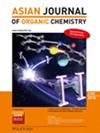Ultrasmall Fe3O4 Nanoparticles on ZrO2 as Catalysts for CO2 Hydrogenation to Lower Olefins
IF 2.8
4区 化学
Q1 CHEMISTRY, ORGANIC
引用次数: 0
Abstract
Organic synthesis presents significant opportunities for converting the abundant and hazardous carbon dioxide (CO2) in the atmosphere into a more sustainable carbon source. To reduce the carbon footprint, we explored the direct hydrogenation of CO2 to lower (C2‐4=) olefins using various catalysts composed of ZrO2‐supported alkali‐metal‐promoted superparamagnetic iron oxide nanoparticles (SPIONs; Fe3O4). These catalysts are notable for their straightforward preparation; we employed a cost‐effective dry‐mixing method to create a range of alkali metal‐doped SPIONs supported on ZrO2. Results showed that the strong interactions between Fe3O4 and the ZrO2 support enhanced CO2 hydrogenation performance compared to other forms.. Under optimal conditions – using a gas hourly space velocity (GHSV) of 4500 mL/h/gcat. and a feed ratio of H2:CO2=3 : 1 – this catalyst achieved over 22 % CO2 conversion and high selectivity for light (C2–4=) olefins at 30 bar and 375 °C, with 30 wt% Fe3O4 loading on ZrO2 and 2 wt% K promoter. We also investigated several variables, including alkali metal concentration, iron content, reaction conditions, and catalyst stability over 96 hours.

求助全文
约1分钟内获得全文
求助全文
来源期刊

Asian Journal of Organic Chemistry
CHEMISTRY, ORGANIC-
CiteScore
4.70
自引率
3.70%
发文量
372
期刊介绍:
Organic chemistry is the fundamental science that stands at the heart of chemistry, biology, and materials science. Research in these areas is vigorous and truly international, with three major regions making almost equal contributions: America, Europe and Asia. Asia now has its own top international organic chemistry journal—the Asian Journal of Organic Chemistry (AsianJOC)
The AsianJOC is designed to be a top-ranked international research journal and publishes primary research as well as critical secondary information from authors across the world. The journal covers organic chemistry in its entirety. Authors and readers come from academia, the chemical industry, and government laboratories.
 求助内容:
求助内容: 应助结果提醒方式:
应助结果提醒方式:


